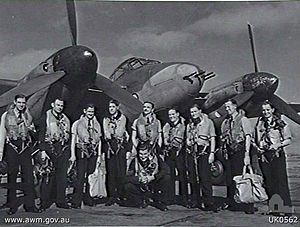- No. 456 Squadron RAAF
-
No. 456 Squadron RAAF 
Members of No. 456 Squadron RAAF in front of a de Havilland Mosquito night fighter in 1943Active 30 June 1941 – 15 June 1945 Country  Australia
AustraliaAllegiance  United Kingdom
United KingdomBranch  Royal Australian Air Force
Royal Australian Air ForceRole Night fighter Part of No. 9 Group RAF, Fighter Command[1]
No. 10 Group RAF, Fighter Command[2]
No. 11 Group RAF, Fighter Command[3]Battle honours
- Fortress Europe, 1940–1944
- France and Germany, 1944–1945
- Normandy, 1944
- Biscay, 1940–1945
Insignia Squadron Codes PZ (Jun 1941 – Sep 1941)[4][5]
SA (Sep 1941 – Dec 1941)[6]
RX (Dec 1941 – Jun 1945)[6][7]No. 456 Squadron RAAF was a Royal Australian Air Force night fighter squadron, active over Europe during World War II.
Contents
History
No. 456 Squadron was formed on 30 June 1941 at RAF Valley, Isle of Anglesey, Wales in the United Kingdom under the Empire Air Training Scheme as a night fighter squadron, equipped with Defiant turret-fighters. The Squadron was soon re-equipped with Beaufighters and scored its first kill in January 1942. In December 1942 the Squadron was re-equipped with Mosquito fighters and began offensive (Ranger) missions over Europe. No. 456 Squadron continued in the fighter and ground attack roles until the end of the European war when it was disbanded on 15 June 1945 at RAF Bradwell Bay, Essex.
Aircraft operated
Aircraft operated by no. 456 Squadron RAAF, data from[8][9][10] From To Aircraft Version June 1941 November 1941 Boulton Paul Defiant Mk.I September 1941 July 1942 Bristol Beaufighter Mk.IIf July 1942 January 1943 Bristol Beaufighter Mk.VIf December 1942 April 1944 de Havilland Mosquito Mk.II June 1943 October 1943 de Havilland Mosquito Mk.VI January 1944 February 1945 de Havilland Mosquito Mk.XVII December 1944 June 1945 de Havilland Mosquito Mk.XXX Squadron bases
Bases and airfields used by no. 456 Squadron RAAF, data from[8][9][10] From To Base Remark 30 June 1941 30 March 1943 RAF Valley, Isle of Anglesey, Wales Det. at RAF Colerne, 15–30 Mar 43 30 March 1943 17 August 1943 RAF Middle Wallop, Hampshire Dets. at RAF Castle Camps, Cambridgeshire
and RAF Predannack, Cornwall17 August 1943 17 November 1943 RAF Colerne, Wiltshire 17 November 1943 29 February 1944 RAF Fairwood Common, Glamorgan, Wales 29 February 1944 30 December 1944 RAF Ford, West Sussex 30 December 1944 16 March 1945 RAF Church Fenton, Yorkshire 16 March 1945 15 June 1945 RAF Bradwell Bay, Essex Commanding officers
Officers commanding no. 456 Squadron RAAF, data from[8][11] From To Name 30 June 1941 27 March 1942 Wing Commander C.G.C. Olive, DFC 27 March 1942 1 February 1943 Wing Commander E.C. Wolfe 1 February 1943 1 June 1943 Wing Commander M.H. Dwyer 1 June 1943 14 December 1943 Wing Commander G. Howden 14 December 1943 1 July 1944 Wing Commander K.M. Hampshire, DSO 1 July 1944 29 May 1945 Wing Commander B. Howard, DFC 29 May 1945 15 June 1945 Squadron Leader R.B. Cowper References
Notes
- ^ Delve 1994, p. 57.
- ^ Rawlings 1978, p. 526.
- ^ Rawlings 1978, p. 529.
- ^ Bowyer and Rawlings 1979, p. 84.
- ^ Flintham and Thomas 2003, p. 98.
- ^ a b Flintham and Thomas 2003, p. 105.
- ^ Bowyer and Rawlings 1979, p. 91.
- ^ a b c Rawlings 1978, p. 447.
- ^ a b Halley 1988, p. 478.
- ^ a b Jefford 2001, p. 94.
- ^ Australian War Memorial: 456 squadron
Bibliography
- Bennet, John. Fighter Nights: 456 Squadron RAAF. Belconnen, Australia: Banner Books, 1995. ISBN 1-87559-310-1.
- Bowyer, Michael J.F. and John D.R. Rawlings. Squadron Codes, 1937–56. Cambridge, UK: Patrick Stephens Ltd., 1979. ISBN 0-85059-364-6.
- Delve, Ken. The Source Book of the RAF. Shrewsbury, Shropshire, UK: Airlife Publishing, 1994. ISBN 1-85310-451-5.
- Flintham, Vic and Andrew Thomas. Combat Codes: A full explanation and listing of British, Commonwealth and Allied air force unit codes since 1938. Shrewsbury, Shropshire, UK: Airlife Publishing Ltd., 2003. ISBN 1-84037-281-8.
- Halley, James J. The Squadrons of the Royal Air Force & Commonwealth 1918–1988. Tonbridge, Kent, UK: Air Britain (Historians) Ltd., 1988. ISBN 0-85130-164-9.
- Jefford, Wing Commander C.G., MBE, BA, RAF(Retd.). RAF Squadrons, a Comprehensive record of the Movement and Equipment of all RAF Squadrons and their Antecedents since 1912. Shrewsbury, Shropshire, UK: Airlife Publishing, 1988 (second edition 2001). ISBN 1-85310-053-6.
- Lewis, Stephen with Bob Cowper. Chasing Shadows -Wartime biography of Squadron Leader Bob Cowper. Adelaide, SA: DPA Publishing, 2007. ISBN 1-92120-715-9.
- RAAF History section. Units of the Royal Australian Air Force: a concise history. Volume 2 fighter units. Canberra: Australian Government Publishing Service, 1995.
- Rawlings, John D.R. Fighter Squadrons of the RAF and their Aircraft. London: Macdonald & Jane's (Publishers) Ltd., 1969 (2nd edition 1976, reprinted 1978). ISBN 0-354-01028-X.
External links
Related content
Main series 1 · 2 · 3 · 4 · 5 · 6 · 7 · 8 · 9 · 10 · 11 · 12 · 13 · 14 · 15 · 20 · 21 · 22 · 23 · 24 · 25 · 26 · 27 · 28 · 29 · 30 · 31 · 32 · 33 · 34 · 35 · 36 · 37 · 38 · 40 · 41 · 42 · 43 · 60 · 66 · 67 · 71 · 73 · 75 · 76 · 77 · 78 · 79 · 80 · 82 · 83 · 84 · 85 · 86 · 87 · 92 · 93 · 94 · 99 · 100 · 102 · 107 · 292 · Fighter · Rescue and Communication · Seaplane · Berlin Air Lift
Article XV squadrons Joint Netherlands-Australian squadrons Categories:- RAAF squadrons
- Military units and formations established in 1941
- Article XV squadrons of World War II
Wikimedia Foundation. 2010.
